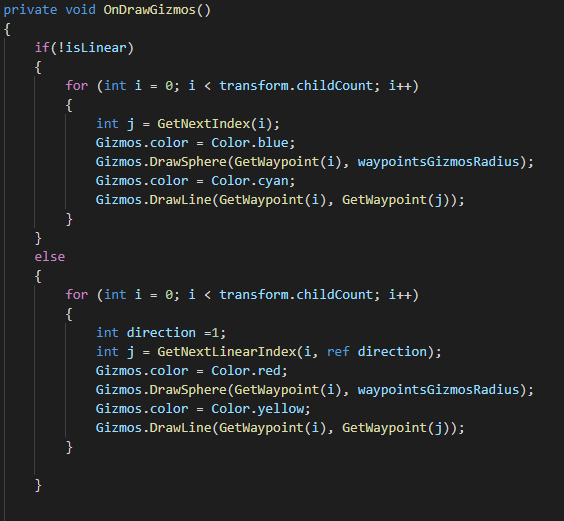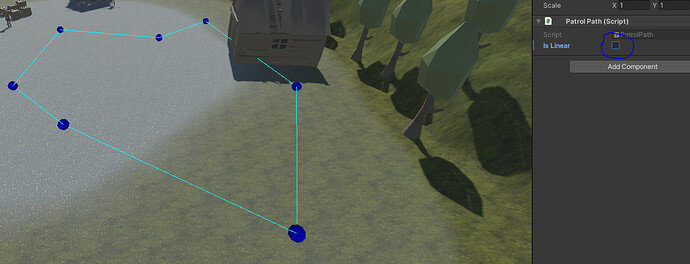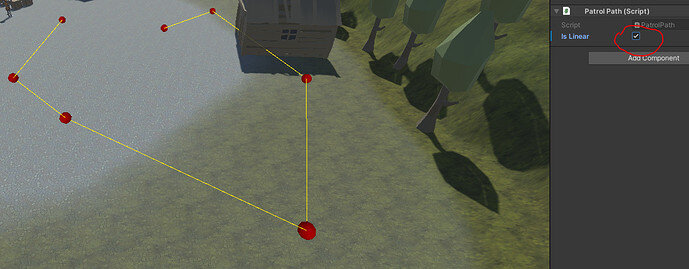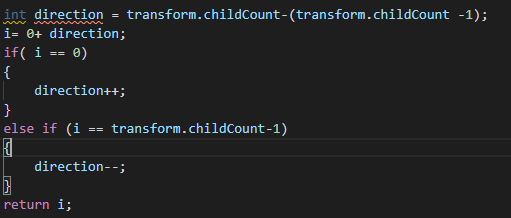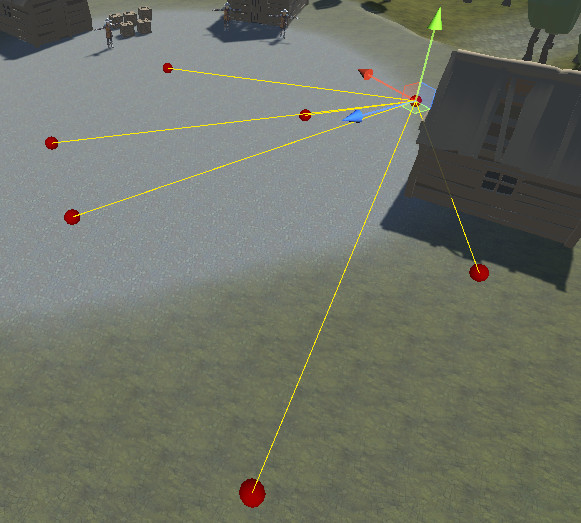Let’s go back to the GetNextIndex I made for my example:
public int GetNextLinearIndex(int i, ref int direction)
{
int result = i + direction;
if (result >= transform.childCount || result <0)
{
direction *= -1;
return i + direction;
}
return result;
}
Here’s how it works:
We start by calculating what our next waypoint should be based on the direction passed into the method. Direction should only ever be 1 or -1, assuming it is never altered outside of this formula and it’s initialized correctly as a global variable in your AI Controller.
So Let’s assume we have 5 waypoints. In our AIController, the first waypoint is zero. We’ve arrived there, and want the next waypoint, so we CycleWaypoint
private void CycleWaypoint()
{
if (patrolPath.IsLinear())
{
currentWaypointIndex = patrolPath.GetNextLinearIndex(currentWaypointIndex, ref direction);
}
else
{
currentWaypointIndex = patrolPath.GetNextIndex(currentWaypointIndex);
}
}
So GetNextLinearIndex() should be getting a currentIndex of 0, and a direction of 1. It adds the two together, 0+1=1
Then it does it’s bounds check to make sure that the index isn’t greater than the number or children or less than 0. Our result is 1, so we don’t touch direction, and we return 1.
This continues until our currentIndex is 4. When it’s 4, the GetLinearIndex is sent (4,1). Our method gets a result of 5, which is equal to the child count. We can’t return 5 because our index is zero based, it’s time to go the other way. So the direction is flipped (1 * -1 = 1), and we send a new result of i+direction which is now 4 + -1 = 3
Now direction has become -1, and we continue down our path. The next call to CycleWaypoint() will be sending (3,-1) with a result of 2 and the ref remaining unchanged at -1
(2, -1) = 1
(1, -1) = 0
(0, -1) We’re now in the special case where the result (-1) is out of bounds. Once again, we flip the direction (-1 * -1 = 1) and return the passed index + direction (0 + 1 = 1).
So here’s the whole result cycle
(0,1) = 1
(1,1) = 2
(2,1) = 3
(3,1) = 4
(4,1) = 3 with the direction changed to -1
(3, -1) = 2
(2, -1) = 1
(1, -1) = 0
(0, -1) = 1 with the direction changed to 1
[cycle repeats]
For your OnDrawGizmos(), it doesn’t matter that the direction is within the for block, because it’s still going to flip only once anyways, and it will still draw correctly.
I anticipate that this is because in AIController, you’re declaring int direction = 1; inside the CycleWaypoint() method instead of outside the method. direction should be a global variable. If it’s declared within CycleWaypoint() then you get
(0,1) = 1
(1,1) = 2
(2,1) = 3
(3,1) = 4
(4,1) = 3 direction is changed to -1, but is discarded because direction is a local
(3,1) = 4
(4,1) = 3...this will continue between the last and next to last element



